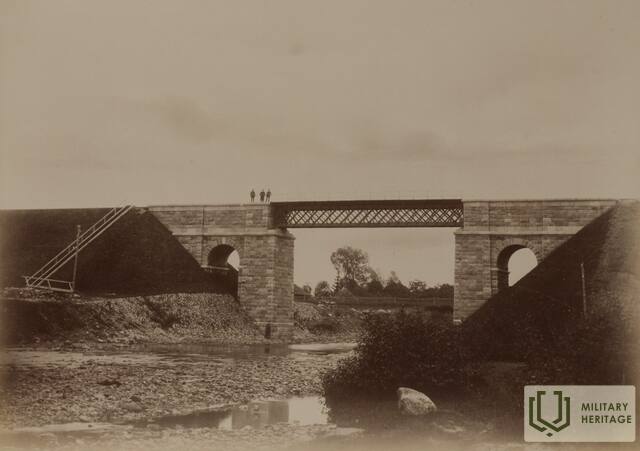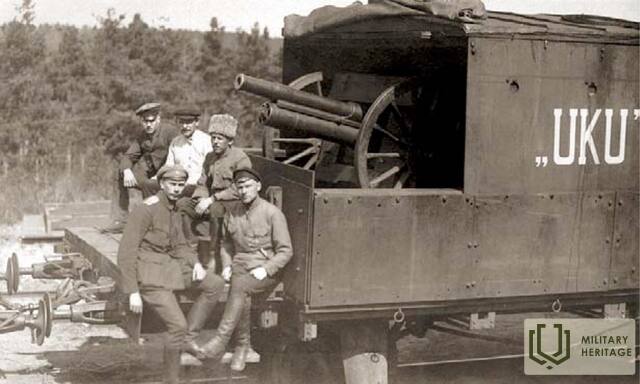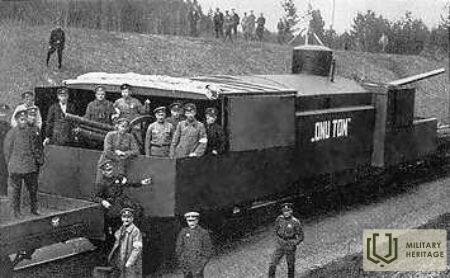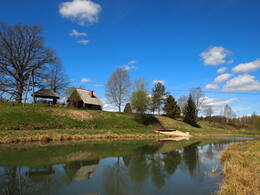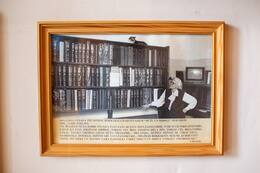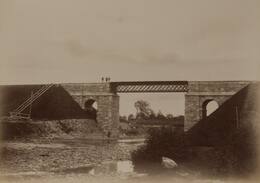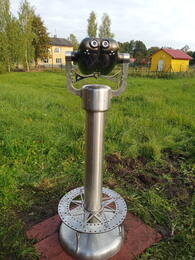Battle at the bridge over Amata River
The Battle of Cēsis is one of the most important stages of the War of Independence of Latvia and occupies an important place in the history of the War of Independence of Estonia.
The Battle of Cēsis is one of the most important stages in the War of Independence of Latvia. It also holds an important place in the history of the War of Independence of Estonia. The Republic of Latvia was founded on November 18, 1918. Already in December 1918, the recently established Provisional Government of Latvia had to organise defence against the threat of Bolshevik troops approaching from Soviet Russia. At the end of December 1918, the recently formed National Guard units or Landeswehr in German, which were formed by Latvian, German and Russian subunits, retreated to Kurzeme. At the same time, the Provisional Government of Latvia sought help in Estonia, where, in February 1919, Latvians living in Estonia had started to form the so-called Northern Latvian brigade, which was incorporated in the Estonian army. On April 16, 1919, the German units of Landeswehr organised a coup in Liepāja, overthrowing the Provisional Government of Latvia, which was led by Kārlis Ulmanis, and establishing their own government under the leadership of pastor and writer Andrievs Niedra. When the units of Landeswehr regained Riga on May 22, 1919, this completely demoralised the Soviet forces, and they quickly retreated from Vidzeme to Latgale. The units of the Landeswehr followed them until they encountered the units of the Estonian Army and the Northern Latvian Brigade. A conflict started between the two sides, which developed into the Battle of Cēsis.
The battle at the bridge over the Amata River took place on June 5, 1919 between the armoured trains of the Estonian army and the German Landeswehr units. This clash started the first stage of the Battle of Cēsis, which lasted until the armistice concluded on June 10. The battles of Cēsis resumed with new power on June 19 with the attack of the Landeswehr and the Iron Division on Limbaži and the subsequent attack in the direction of Valmiera. Over several days of intense fighting, the Estonian army and the units of the Northern Latvian brigade stopped the attack, launched a counterattack, and finally defeated the Germans. The conflict was escalated by the intransigence of the two sides on the issue of military operations in Vidzeme - units of the Estonian Army and Northern Latvian Brigade attacked from the north and occupied territories up to Valmiera, and successfully advanced towards Gulbene and Madona, reaching Jēkabpils, while the Landeswehr's units had to reach the area of Ape - Alūksne. The Ieriķi – Gulbene and Ieriķi – Valka railway lines were important, providing transport and supply opportunities. Therefore, the opportunity to control the strategically railway junction in Ieriķi was important for both sides involved in the conflict.
After the liberation of Northern Vidzeme from the Bolsheviks, the high command of the Northern Latvian Brigade arrived in Cēsis on June 2. At the same time, an armoured German train arrived in Ieriķi and demanded permission to advance to Cēsis. The following days saw a show of force, intensive correspondence, and negotiations between the representatives of the Estonian Army, the Northern Latvian Brigade and Landeswehr, each side trying to achieve its goal: the Landeswehr - to continue their advance to the north, and the Estonian army - to make the Landeswehr retreat to the Mouth of the river Gauja - Sigulda - Nītaure – Vecpiebalga – Jaungulbene line.
To clarify the situation with the railways and check whether the Germans were destroying the railway, two Estonian armoured trains - No. 2. and No. 4 - slowly began to scout the situation in the direction of Riga on June 5, around 1:45 pm. Lieutenant-Colonel Nikolajs Rēks accompanied the trains and was responsible for the negotiations with the Landeswehr, the Chief of Staff of the Northern Latvian Brigade, Colonel-Lieutenant Voldemārs Ozols, and the United States of America military representative, Captain Dawley (or Colonel Warwick Greene according to other reports). Well-versed in the local conditions, a soldier of the 8th Student Company of the recently formed 2nd Cēsis Infantry Regiment, Kārlis Dzirkalis was also assigned to the operation. Near the bridge over the Amata, a guard soldier stopped the train, announcing that the Germans had mined the bridge. As the sappers were searching the bridge, shots suddenly rang out from the other side, injuring the Estonian sergeant and killing the officer. Immediately, a chain of Landeswehr soldiers appeared from the nearby forest and opened fire on the armoured train. At the same time, the Germans tried to surround the other train, but it drove them away with artillery fire.
The Battle of Cēsis stopped and limited Germany's expansion in the Baltics. The scale of these battles is comparable to the so-called Bermontiada in the autumn of 1919 near Riga. In Estonia, they are called Võnnu lahing, and the culmination of the victory of these battles - Victory Day on June 23 - is celebrated as a national holiday.
Learn more about the Battle of Cēsis along the dedicated touring route: In the footsteps of the Battle of Cēsis - https://militaryheritagetourism.info/en/tours
Related timeline
Related topics
Related objects
Recreation Place “Meža kaujas”, the Main Venues of the Cēsis Battles near the Amata Bridge
Named Forest Battles, the rest area is situated in the main location of the Battles of Cēsis near the Amata bridge. Visitors can listen to stories about the Battles of Cēsis and can take part in various activities, including hikes and trips around the most important venues of the Battles of Cēsis, and team battles. At the end, the visitors can enjoy an invigorating wartime soup. The railway bridge over Amata played a very important role throughout the War of Independence, as the first clashes of the Estonian Army with the Landeswehr took place here. On 5 June 1919, the first battle of the Estonian Army’s armoured trains with the Baltic Landeswehr units took place by the railway bridge over Amata. The Landeswehr, knowing that an armoured train was approaching, planted mines on the railway bridge and secured positions at the homestead Amatas on the riverbank in preparation for a possible battle. The bridge over Amata marked the border between Estonian forces and the Germans. On the night of 23 June 1919, during the Battles of Cēsis, the Landeswehr left Cēsis and retreated to the Amata river line. When retreating, the Germans burned down the Cēsis Latvian Society House and blew up the bridge over Amata.
A unique opportunity is offered to watch the events of June 5, 1919 through virtual reality glasses.
Museum of Melānija Vanaga and Siberian dugout
The Melānija Vanaga Museum is located in the Amata village school in Cēsis municipality. The museum showcases materials about the life, literary activity, family and destiny of writer and cultural historian Melānija Vanaga: video content about Siberia and the deported Latvians living there and a Siberian dugout taking its visitors on a trip to the writer’s place of deportation in Tyukhtetsky district, Krasnoyarsk region. The appearance and layout of the dugout form a realistic idea of life away from home. The dugout features unique historical objects brought there from the Tyukhtet Museum: a birch-bark dish known as ‘tuyesok’, a clay mug known as ‘krynka’ and a kerosene lamp. The museum features video interviews with politically repressed people from the municipality and 18 characters from Melānija Vanaga’s book Suddenly, a Criminal: Sixteen Years in Siberia. The museum’s virtual exhibition ‘BE YOURSELF!’ (http://esipats.lv) shows the experiences of five deported children and their parents who were wrongly accused by the Soviet authorities of ‘betrayal of the motherland’.
Memorial place near Amata station - echelon No. 97322
It is located in Drabešu parish of Amata county, near the former Amata station building.
The deportees' memorial with an information board and a square can be viewed.
A total of more than 42 thousand people were taken from Latvia in 33 echelons on March 25, 1949 and the following days.
On March 27, 1949, at two o'clock in the morning, echelon No. 60 long wagons left Amata station. 97322 with 329 men, 596 women, 393 children.
The central object will be 1318 metal poles of various sizes and colors. Each of them symbolizes a person taken on March 25, 1949 from the then counties of Cēsis and Alūksne. On each column, the name, surname, year of birth and parish - from which the person was sent. At the moment, 21 posts have been installed with the support of the deportees themselves or their relatives.
The author of the idea, Pēteris Ozolas himself, also has his own pillar, who was taken from "Pērkonių" of Kos parish together with his family at the age of six on March 25, 1949.
Information about the deportation of 1949 and the operation "Priboi" (Coastal Wave) carried out by the repressive organs of the USSR in the occupied Baltic states, which was the basis of the deportation, can be read on the information board.
Railway bridge over Amata
Located in Drabešu parish, Cēsis region, near the recreation place "Meža kaujas".
There is a railway bridge over Amata.
The railway bridge over Amata played a very important role throughout the War of Independence, because on June 5, 1919, the first battle of the Estonian army's armed trains with the Baltic Landesver units took place here. Landeswehr, knowing that an armed train was approaching, nominated a railway bridge and took a position at the Amatas home on the river bank, ready for possible warfare. The bridge over Amata was the border between Estonian forces and the Germans.
Historical evidence of the events at the Amata Bridge has not been preserved. As Latvians did not take part in these events, there are no narratives of their memories, there are memories from Estonian soldiers and other sources. It can be said that this was an Estonian-American joint battle against the Landeswehr, because there was an American officer on the Estonian armored train, who later fought in World War II as well. In general, many future World War II officers and commanders took part in the battles of Cēsis, especially on the German side.
The Estonian armed train arrived in Cēsis on June 2, 1919, a day later went to Ieriķi, where talks took place with the landlord, which was unsuccessful, and on June 5, when the armed train approached the Amata bridge again, a collision with the Germans began. A day later, the armed train also took part in the battles near Cēsis, where it helped the soldiers of the Pupils' Company who were threatened with siege. Although the Germans tried to dismantle the rails to cut off the train's retreat, it managed to retreat across the Rauna bridge.
On the night of June 23, 1919, during the battles of Cēsis, the landesver left Cēsis and retreated to the Amata river line. When they retreated, the Germans burned down the house of the Cēsis Latvian Society and blew up a bridge over Amata.
Virtual reality binoculars "Battles of Cēsis"
The Battle of Cēsis was one of the most important turning points in the course of the Latvian War of Independence (1918 - 1920). On June 5, 1919, the first stage of the Battle of Cēsis began with a clash between armored trains of the Estonian army and units of the Landesvær near the Ierikai railway station near the bridge over Amata. In commemoration of this event, a tourist object has been created near the Ierikai station, which offers to experience the story of history using the possibilities provided by modern technology - with the help of virtual reality. The five-minute video "BATTLE FOR OFFICE BRIDGE" can be viewed free of charge in virtual reality binoculars every day. Video duration: 5 min., LV with subtitles LV, ENG, EST and EU.




